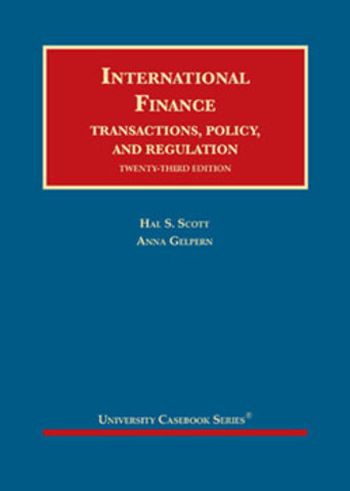
This textbook provides comprehensive coverage of international finance from policy, regulatory, and transactional perspectives. The introductory chapter begins with core legal and economic concepts, followed by an overview of major financial market and policy institutions, and the problem of systemic risk, which increasingly motivates regulation. Chapter 2 anchors the remainder of the book in the analysis of two financial and economic crises: the 2007-2008 global financial crisis, which has informed many of the regulatory policies and market adaptation episodes discussed in the book, and the COVID-19 pandemic in 2020. While the material on the 2020 crisis primarily addresses the U.S. experience, it also covers parts of Europe and Asia. Discussion of the pandemic's impact and response highlights major changes in the role of government in the economy and the role of central banks as lenders of last resort.
After the first two chapters, the book is organized in five parts.
Part One deals with the international aspects of banking and securities markets in major financial centers. It covers sweeping reforms in response to the global financial crisis of 2007-2009 and the Eurozone crisis that followed. Among the current issues, we consider the exit of the United Kingdom from the European Union, and its implications for the United Kingdom, Europe, and the rest of the world, as well as Prime Minister Abe’s Three Arrows of Reform program in Japan.
Part Two considers the infrastructure of global financial markets, including payment, clearing and settlement systems, digital currencies, foreign exchange regimes, and international coordination of capital and liquidity requirements. Capital and liquidity regulations are key to government efforts to control systemic risk; after regulatory tightening in the immediate aftermath of the 2007-2009 crisis, these have been progressively relaxed—a trend that continues in response to COVID-19, as detailed in Chapter 2.
Part Three deals with major market instruments, including securitization and derivatives contracts, and the regulation of asset managers. The asset management material builds on our discussion of securities markets in Part One, and considers the implications of the rise of index funds and private equity.
Part Four focuses on the emerging markets, and covers project finance, debt crises, and international institutions for development finance and financial crisis response. The book includes discussion of the new and long-festering controversies as it went to print: Argentina sinking back into sovereign debt default for the second time in six years, Venezuela's economic collapse and debt default, which continued with no resolution in sight, and initiatives by international officials and multilateral institutions to manage a large wave of debt restructurings expected as part of the fallout from COVID-19. The chapter on China focuses on the U.S.–China relationship, including an important trade agreement negotiated in early 2020, which would further open the Chinese financial sector and limit exchange rate manipulation.
Part Five addresses the challenge of controlling the financing of terrorism.